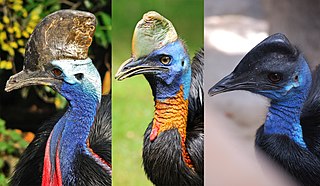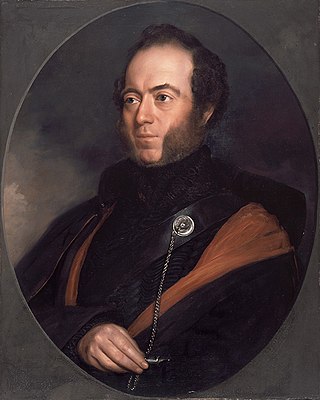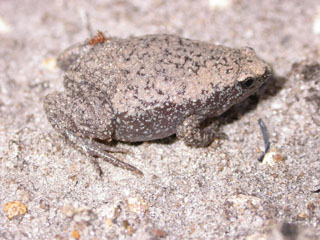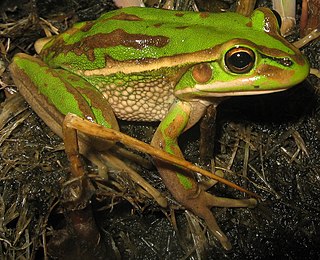
Cassowaries are flightless birds of the genus Casuarius in the order Casuariiformes. They are classified as ratites: flightless birds without a keel on their sternum bones. Cassowaries are native to the tropical forests of New Guinea, The Moluccas, and northeastern Australia.

Bandicoots are a group of more than 20 species of small to medium sized, terrestrial, largely nocturnal marsupial omnivores in the order Peramelemorphia. They are endemic to the Australia–New Guinea region, including the Bismarck Archipelago to the east and Seram and Halmahera to the west.

Sir Thomas Livingstone Mitchell, often called Major Mitchell, was a Scottish surveyor and explorer of Southeastern Australia. He was born in Scotland and served in the British Army during the Peninsular War. In 1827 he took up an appointment as Assistant Surveyor General of New South Wales. The following year he became Surveyor General and remained in this position until his death. Mitchell was knighted in 1839 for his contribution to the surveying of Australia.

Nothofagus, also known as the southern beeches, is a genus of 43 species of trees and shrubs native to the Southern Hemisphere in southern South America and east and southeast Australia, New Zealand, New Guinea, and New Caledonia. The species are ecological dominants in many temperate forests in these regions. Some species are reportedly naturalised in Germany and Great Britain. The genus has a rich fossil record of leaves, cupules, and pollen, with fossils extending into the late Cretaceous period and occurring in Australia, New Zealand, Antarctica, and South America.

Bourke's parrot, also known as the blue-vented parrot, sundown parrot, pink-bellied parrot, Bourke's parakeet, Bourke or "Bourkie", is a small parrot found in Australia and the only species in its genus, Neopsephotus. It is approximately 19 cm long and weighs around 45 grams. It is named after General Sir Richard Bourke, Governor of New South Wales from 1831 to 1837.

The Microhylidae, commonly known as narrow-mouthed frogs, are a geographically widespread family of frogs. The 683 species are in 57 genera and 11 subfamilies.

Livistona is a genus of palms, the botanical family Arecaceae, native to southeastern and eastern Asia, Australasia, and the Horn of Africa. They are fan palms, the leaves with an armed petiole terminating in a rounded, costapalmate fan of numerous leaflets.

The Australian green tree frog, also known as simply green tree frog in Australia, White's tree frog, or dumpy tree frog, is a species of tree frog native to Australia and New Guinea, with introduced populations in the United States and New Zealand, though the latter is believed to have died out. It is morphologically similar to some other members of its genus, particularly the magnificent tree frog (R. splendida) and the white-lipped tree frog (R. infrafrenata).

The scarlet-chested parrot, known alternately as scarlet-breasted parrot, orange-throated parrot or splendid parrot, is a parrot endemic to central South Australia and inland southern Western Australia. The species is sexually dimorphic; the male has a bright blue face and scarlet chest and yellow underparts, amid overall green plumage, while the female is similar but lacks the red chest. These nomadic parakeets move readily from the Great Victoria Desert region into neighbouring areas. These interruptions are triggered by a search for more favourable conditions. They can survive quite well without access to drinking water, however, as succulent plants help meet much of their fluid requirement. They feed mainly on grass seeds and are most commonly sighted in spinifex.

The New Guinea big-eared bat or Papuan big-eared bat,, is a vesper bat endemic to Papua New Guinea. It is listed as a critically endangered species due to ongoing habitat loss. It is the only known member of the genus Pharotis, which is closely related to Nyctophilus.

Howlong is a town 28 kilometres (17 mi) west of Albury, and is situated on the Murray River which separates the Australian states of New South Wales and Victoria. The town is located on the Riverina Highway. There is a bridge across the Murray into Victoria. Howlong is in the Federation Council local government area. At the 2021 census, Howlong had a population of 2,997.

The Hemiscylliidae are a family of sharks in the order Orectolobiformes, commonly known as longtail carpet sharks and sometimes as bamboo sharks. They are found in shallow waters of the tropical Indo-Pacific.

Protemnodon is an extinct genus of megafaunal macropodids that existed in Australia, Tasmania, and New Guinea in the Pliocene and Pleistocene. Members of this genus are also called giant kangaroos.

Hydriastele is a diverse and widespread genus of flowering plant in the palm family found throughout northern Australia, Melanesia, Polynesia, and Southeast Asia. It consisted of just nine species until 2004, when molecular research, supported by morphologic similarities, led taxonomists to include the members of the Gulubia, Gronophyllum, and Siphokentia genera. About 40 species are now recognized.

Amyema quandang is a species of hemi-parasitic shrub which is widespread throughout the mainland of Australia, especially arid inland regions, sometimes referred to as the grey mistletoe.

Abispa splendida is a species of wasp in the Vespidae family.

Abispa laticincta is a species of wasp in the Vespidae family.

Oxera splendida is an evergreen vine in the family Lamiaceae which produces white, fragrant flowers and white, egg-shaped fruit. It naturally is occurs in the tropical rain forests of tropical Asia and Australia and is often sighted along rain forest margins such as roads. Some common names include October glory, glory vine, potato vine and fragrant faradaya. Australian indigenous names include Garanggal used from Cairns to Yarrabah, Buku used in the Tully River area, Koie-yan used at Dunk Island and Djungeen used by the Girramay clan.
Abispa australiana is a species of wasp in the Vespidae family. It was described as Vespa australiana by Thomas Livingstone Mitchell in 1838.

Ranoidea is a genus of frogs in the subfamily Pelodryadinae. They are found in Australia, New Guinea, and two nearby groups of islands: the Maluku Islands, and the Louisiade Archipelago. The circumscription of this taxon is still controversial.



















